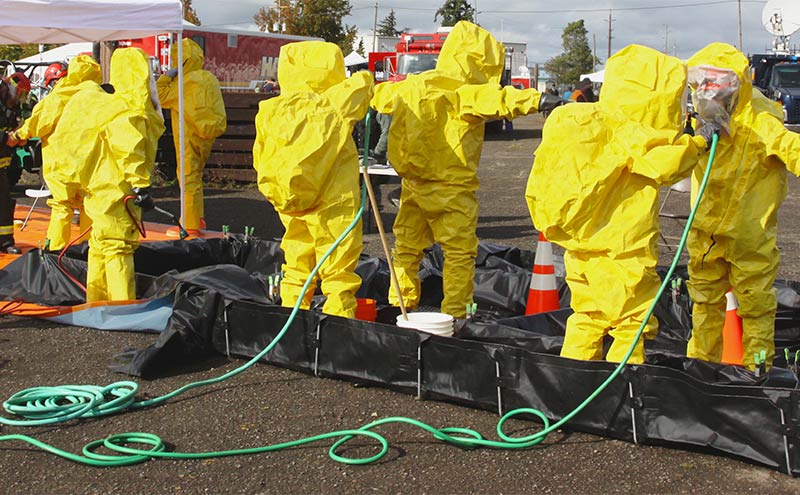
Chemical Disasters
Preparing your emergency department for chemically-contaminated patients requires pre-planning, training, and knowledge of how to respond when a chemical-related incident occurs. This document contains a compilation of several resources to assist with training and response to chemical disasters for emergency physicians. While it is important to have resources, apps, and internet tools to utilize for preparedness, nothing supersedes exercising your emergency department’s chemical emergency preparedness plans, to ensure that you are ready when you need to be.
When faced with chemically-contaminated patients, gaining situational awareness by communicating with witnesses, patients, pre-hospital responders, and any involved HAZMAT teams, along with employing chemical toxidrome recognition, is of utmost importance in planning your response. While we may not always be able to determine exactly which chemical patients may have been exposed to, it is through the toxidrome recognition and adequate history gathering that allows narrowing down of a chemical to a ‘group’ of chemicals. Identifying a toxidrome or chemical group will assist in the selection of triage needs, patient handling, decontamination, PPE, treatment, antidote, and disposition needs.
Information gathering should include:
- Exposure History? (Example: inhalation, skin contact, ingestion, time of day, scene information)
- Toxidrome Recognition? (Examples: irritant/corrosive, cholinergic, knockdown gas, anesthetic/sedative)
- Chemical Properties (example: vapor, gas, liquid, solid, noxious or chemical warning properties?) from EMS or facility response team or
- Safety Data Sheet - Pre-Hospital Care Measures? (i.e. decontamination, treatments?)
- Security or terrorism involvement possibility? (For example, may affect your safety considerations in the hospital)
After identification of the type of chemical, or at least the symptoms and route of exposure, the emergency physician can use several resources to plan their response and decontamination needs:
- Poison Control Center (1-800-222-1222)
Response Tools & Resources
Wanner GK, Atti S, Jasper E. Chemical disaster preparedness for hospitals and emergency departments. Delaware Journal of Public Health. 2019; 5(4):68-74 - This article reviews many aspects of chemical disaster preparedness and additional information. Learn More
Emergency Response Guidebook (ERG) (free app) - Often used by first-responders to guide the identification of a chemical (based on the labeling placard) and the initial response to a chemical emergency. The WISER app links to pages from the ERG. Learn More
NIOSH Pocket Guide to Chemical Hazards (website & free app) - Provides detailed information about chemical hazards and recommendations for first aid and personal protective equipment. Serves as an additional clinical reference. Learn More
American Association of Poison Control Centers: 1-800-222-1222 phone number connects anyone in the U.S.A. to their local poison center (based on phone area code). All calls are answered by a medical professional, with the goal of providing immediate poison exposure management instructions in the event of a chemical emergency.
Strategic National Stockpile (SNS) - The SNS program is designed to supplement and re-supply state and local inventories of medicines and supplies during emergencies severe enough to exhaust local supplies. Decisions about what medicines and materiel should be included in the SNS are made by the HHS Assistant Secretary of Preparedness and Response (ASPR), the HHS, the Department of Homeland Security (DHS), and the CDC, in consultation with state and local public health officials and private sector organizations and entities. Learn More
CDC’S CHEMPACK Program (the stockpile that may protect you in a chemical attack) - CHEMPACKs are deployable containers of nerve agent antidotes that work on a variety of nerve agents and can be used even if the actual agent is unknown. Traditional stockpiling and delivery would take too long because these antidotes need to be administered quickly. CDC’s CHEMPACK team solves this problem by maintaining 1,960 CHEMPACKs strategically placed in more than 1,340 locations in all states, territories, island jurisdictions, and the District of Columbia. Most are located in hospitals or fire stations selected by local authorities to support a rapid hazmat response. More than 90% of the U.S. population is within one hour of a CHEMPACK location, and if hospitals or first responders need them, they can be accessed quickly. The delivery time ranges from within a few minutes to less than 2 hours. What is CHEMPACK?
Training Resources
FEMA Intro to Hazardous Materials (free, online)
Part of FEMA’s online Emergency Management Institute, this course provides a general introduction to hazardous materials identification and material safety data sheets (MSDS or SDS). It does not provide specific information on the treatment of these patients.
Center for Domestic Preparedness (CDP) Courses
Hazardous Materials Awareness (free, online)
Appears to meet the NFPA/OSHA requirements for Hazardous Materials Awareness level training.
Hospital Emergency Response Team (HERT) training (free, in-person course)
Classroom and practical 24-hour operations-level training involving the use of Level C personal protective equipment to evaluate, triage, and decontaminate patients from a mass-casualty exposure incident. Courses through the CDP are typically free, especially for state/local responders, but require approval through the state contact person listed on the CDP website.
HERT-Basic, train-the-trainer (free, in-person course)
This 8-hour course is typically linked to the above HERT training and qualifies graduates to teach the 8-hour HERT-Basic course at their home facility.
Advanced Hazmat Life Support (AHLS)
The AHLS course is taught by a board-certified toxicologist, physician, and other AHLS instructors. These expert instructors train health-care professionals to become AHLS providers and care for victims of hazmat incidents and toxic terrorism.
Chemical Agents of Opportunity for Terrorism: Toxic Industrial Chemicals (TICs) & Toxic Industrial Materials (TIMs)
Includes links to webinars for the courses.
OSHA HAZWOPER Regulation
The hazardous waste operations and emergency response (HAZWOPER) regulation is commonly cited in relation to the emergency response to chemical disasters. Subsection “q” (1910.120(q)) appears to be most applicable to the emergency department response. The links below feature the full OSHA standard (29 CFR 1910.120) and an OSHA-produced publication highlighting the recommended training for first receivers.
Reference Articles
- Chilcott RP, Larner J, Durrant A, et al. Evaluation of US Federal Guidelines (Primary Response Incident Scene Management [PRISM]) for Mass Decontamination of Casualties During the Initial Operational Response to a Chemical Incident. Ann Emerg Med. 2019;73(6):671-684. Learn More
- Larner J, Durrant A, Hughes P, et al. Efficacy of Different Hair and Skin Decontamination Strategies with Identification of Associated Hazards to First Responders. Prehosp Emerg Care. 2019;:1-14. Learn More
- Chilcott RP, Mitchell H, Matar H. Optimization of Nonambulant Mass Casualty Decontamination Protocols as Part of an Initial or Specialist Operational Response to Chemical Incidents. Prehosp Emerg Care. 2018;:1-12. Learn More
- James T, Wyke S, Marczylo T, et al. Chemical warfare agent simulants for human volunteer trials of emergency decontamination: A systematic review. J Appl Toxicol. 2018;38(1):113-121. Learn More
- Macintyre AG, Christopher GW, Eitzen E, et al. Weapons of mass destruction events with contaminated casualties: effective planning for health care facilities. JAMA. 2000;283(2):242-9. Learn More
- Lenhart MK, ed. Medical Aspects of Chemical Warfare. Washington, DC: US Government Printing Office; 2008.



